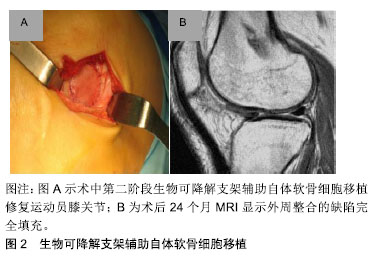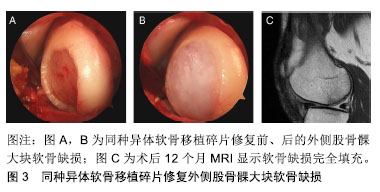| [1]Flanigan DC, Harris JD, Trinh TQ, et al. Prevalence of chondral defects in athletes’ knees: a systematic review.Med Sci Sports Exerc. 2010;42:1795-1801.[2]Heijink A, Gomoll AH, Madry H, et al. Biomechanical considerations in the pathogenesis of osteoarthritis of the knee. Knee Surg Sports Traumatol Arthrosc. 2012;20(3): 423-435. [3]Jones G, Bennell K, Cicuttini FM. Effect of physical activity on cartilage development in healthy kids. Br J Sports Med. 2003; 37:382-383.[4]Goldring MB, Berenbaum F. Emerging Targets in Osteoarthritis Therapy. Curr Opin Pharmacol. 2015;22:51-63. [5]Malfait A-M, Schnitzer TJ. Towards a mechanism-based approach to pain management in osteoarthritis. Nat rev Rheumatol. 2013;9(11):654-664.[6]Gobbi A, Karnatzikos G, Kumar A. Long-term results after microfracture treatment for full-thickness knee chondral lesions in athletes. Knee Surg Sports Traumatol Arthrosc. 2014;22:1986-1996.[7]Kon E, Filardo G, Berruto M, et al. Articular cartilage treatment in high-level male soccer players: a prospective comparative study of arthroscopic second-generation autologous chondrocyte implantationversus microfracture. Am J Sports Med. 2011;39:2549-2557. [8]Ekstrand J, Hägglund M, Kristenson K, et al. Fewer ligament injuries but no preventive effect on muscle injuries and severe injuries: an 11-year follow-up of the UEFA Champions League injury study. Br J Sports Med. 2013;47:732-737.[9]Torrie AM, Kesler WW, Elkin J, et al. Osteochondral allograft. Curr Rev Musculoskelet Med. 2015;8(4):413-422. [10]Marcacci M, Kon E, Delcogliano M, et al. Arthroscopic autologous osteochondral grafting for cartilage defects of the knee: prospective study results at a minimum 7-year follow-up. Am J Sports Med. 2007;35: 2014-2021.[11]Mithoefer K, Peterson L, Zenobi-Wong M, et al. Cartilage issues in football-today’s problems and tomorrow’s solutions. Br J Sports Med. 2015;49(9):590-596. [12]Krych AJ, Robertson CM, Williams RJ III. Return to athletic activity after osteochondral allograft transplantation in the knee. Am J Sports Med. 2012;40:1053-1059.[13]Hindle P, Hendry JL, Keating JF, et al. Autologous osteochondral mosaicplasty or TruFit™ plugs for cartilage repair. Knee Surg Sports Traumatol Arthrosc. 2014,22: 1235-1240. [14]Brittberg M, Lindahl A, Nilsson A, et al. Treatment of deep cartilage defects in the knee with autologous chondrocyte transplantation. N Engl J Med.1994;331:889-895.[15]Peterson L, Vasiliadis HS, Brittberg M, et al. Autologous chondrocyte implantation: a long-term follow-up. Am J Sports Med. 2010;38:1117-1124.[16]Vasiliadis HS, Danielson B, Ljungberg M, et al. Autologous chondrocyte implantation in cartilage lesions of the knee: long-term evaluation with magnetic resonance imaging and delayed gadolinium-enhanced magnetic resonance imaging technique. Am J Sports Med.2010;38:943-949.[17]Mithoefer K, Peterson L, Saris DBF, et al. Evolution and current role of autologous chondrocyte transplantation for the treatment of articular cartilage defects in the football (soccer) player. Cartilage.2012;3(1 Suppl):31S-36S.[18]Mithöfer K, Minas T, Peterson L, et al. Functional outcome of articular cartilage repair in adolescent athletes.Am J Sports Med.2005;33:1147-1153.[19]Della Villa S, Kon E, Filardo G, et al. Does intensive rehabilitation permit early return to sport without compromising the clinical outcome after arthroscopic autologous chondrocyte implantation in highly competitive athletes? Am J Sports Med.2010;38:68-77.[20]Bartlett W, Skinner JA, Gooding CR, et al. Autologous chondrocyte implantation versus matrix-induced autologous chondrocyte implantation for osteochondral defects of the knee: a prospective, randomized study. J Bone Joint Surg Br. 2005;87:640-645.[21]Almonte-Becerril M, Gimeno-LLuch I, Villarroya O, et al. Genetic abrogation of the fibronectin-α5β1 integrin interaction in articular cartilage aggravates osteoarthritis in mice. PLoS One. 2018;13(6):e0198559. [22]Wondrasch B, Risberg MA, Zak L, et al. Effect of accelerated weightbearing after matrix-associated autologous chondrocyte implantation on the femoral condyle: a prospective, randomized controlled study presenting MRI-based and clinical outcomes after 5 years. Am J Sports Med.2015;43:146-153.[23]Ebert JR, Fallon M, Zheng MH, et al. A randomized trial comparing accelerated and traditional approaches to postoperative weightbearing rehabilitation after matrix-induced autologous chondrocyte implantation: findings at 5 years. Am J Sports Med.2012;40:1527-1537.[24]Harris JD, Brophy RH, Siston RA, et al. Treatment of chondral defects in the athlete's knee. Arthroscopy. 2010;26:841-852.[25]Ebert JR, Smith A, Edwards PK, et al. Factors predictive of outcome 5 years after matrix-induced autologous chondrocyte implantation in the tibiofemoral joint. Am J Sports Med. 2013; 41:1245-1254.[26]Mithoefer K, Hambly K, Della Villa S, et al. Return to sports participation after articular cartilage repair in the knee: scientific evidence. Am J Sports Med. 2009;37(Suppl 1): 167S-76S.[27]Foster TE, Puskas BL, Mandelbaum BR, et al. Platelet-rich plasma: from basic science to clinical applications.Am J Sports Med.2009;37:2259-2272.[28]Kon E, Mandelbaum B, Buda R, et al. Platelet-rich plasma intra-articular injection versus hyaluronic acid viscosupplementation as treatments for cartilage pathology: from early degeneration to osteoarthritis. Arthroscopy. 2011; 27:1490-1501.[29]Sanchez M, Fiz N, Azofra J, et al. A randomized clinical trial evaluating plasma rich in growth factors (PRGF-Endoret) versus hyaluronic acid in the short-term treatment of symptomatic knee osteoarthritis. J Arthroscopy. 2012;28: 1070-1078.[30]Morisset S, Frisbee DD, Robbins PD, et al. Il-1ra/IGF-1 gene therapy modulates repair of microfractured chondral defects. Clin Orthop Relat Res. 2007;462:221-228.[31]Neumann K, Dehne T, Endres M, et al. Chodrogenic differentiation capacity of human mesenchymal progenitor cells derived from subchondral corticospongious bone. J Orthop Res. 2008;26:1449-1456.[32]Gille J, Schuseil E, Wimmer J, et al. Mid-term results of Autologous Matrix-Induced Chondrogenesis for treatment of focal cartilage defects in the knee. Knee Surg Sports Traumatol Arthrosc. 2010;18:1456-1464.[33]Stanish WD, McCormack R, Forriol F, et al. Novel scaffold-based BST-CarGel treatment results in superior cartilage repair compared with microfracture in a randomized controlled trial. J Bone Joint Surg Am. 2013; 95:1640-1650.[34]Gobbi A, Karnatzikos G, Sankineani SR. One-step surgery with multipotent stem cells for the treatment of large full-thickness chondral defects of the knee. Am J Sports Med. 2014;42:648-657.[35]Farr J, Tabet SK, Margerrison E, et al. Clinical, radiographic, and histological outcomes after cartilage repair with particulated juvenile articular cartilage: a 2-year prospective study. Am J Sports Med. 2014;42:1417-1425.[36]Jiang Y, Tuan RS. Origin and function of cartilage stem/progenitor cells in osteoarthritis. Nat Rev Rheumatol. 2014;10:1038. [37]Seol D, MaCabe DH, Choe D, et al. Chondrogenic progenitor cells respond to cartilage injury. Arthritis Rheum. 2012;64:3626-3637.[38]Bos PK, Kops N, Verhaar JA, et al. Cellular origin of neocartilage formed at wound edges of articular cartilage in a tissue culture experiment. Osteoarthritis Cartilage. 2008;16: 204-211.[39]Grogan SP, Miyaki S, Asahara H, et al. Mesenchymal progenitor cell markers in human articular cartilage: normal distribution and changes in osteoarthritis. Arthritis Res Ther. 2009;11:R85.[40]Burdick JA, Mauck RL, Gorman JH, et al. Acellular biomaterials: an evolving alternative to cell-based therapies. Sci Transl Med. 2013;5:176-174[41]Yu Y, Brouillette MJ, Seol D, et al. Functional full-thickness articular cartilage repair by rhSDF-1alpha loaded fibrin/ha hydrogel network via chondrogenic progenitor cells homing. Arthritis Rheumatol. 2015;10:1002.[42]Mhanna R, Ozturk E, Vallmajo-Martin Q, et al. GFOGER-modified MMP-sensitive polyethylene glycol hydrogels induce chondrogenic differentiation of human mesenchymal stem cells. Tissue Eng Part A. 2014;20: 1165-1174.[43]Lee CH, Cook JL, Mendelson A, et al. Regeneration of the articular surface of the rabbit synovial joint by cell homing: a proof of concept study. Lancet. 2010;376:440-448.[44]Luria A, Chu CR. Articular cartilage changes in maturing athletes: new targets for joint rejuvenation. Sports Health. 2014,6(1):18-30. |
.jpg) 文题释义:
关节软骨:关节软骨表面光滑,能减少相邻两骨的摩擦,缓冲运动时产生的震动。关节软骨在关节活动中起重要作用,它的结构非常精细和科学,以适应不同的功能需要。了解关节软骨的结构对于理解骨关节痛中的一些问题有重要意义。
软骨祖细胞:2009年Koelling所在的德国研究组定义了软骨祖细胞,该研究将从末期骨关节炎的软骨组织中分离出来的具有祖细胞特征的细胞称为软骨祖细胞。自体软骨祖细胞具有可以快速扩增用于临床修复大面积关节软骨缺损的潜能。
文题释义:
关节软骨:关节软骨表面光滑,能减少相邻两骨的摩擦,缓冲运动时产生的震动。关节软骨在关节活动中起重要作用,它的结构非常精细和科学,以适应不同的功能需要。了解关节软骨的结构对于理解骨关节痛中的一些问题有重要意义。
软骨祖细胞:2009年Koelling所在的德国研究组定义了软骨祖细胞,该研究将从末期骨关节炎的软骨组织中分离出来的具有祖细胞特征的细胞称为软骨祖细胞。自体软骨祖细胞具有可以快速扩增用于临床修复大面积关节软骨缺损的潜能。

.jpg)
.jpg) 文题释义:
关节软骨:关节软骨表面光滑,能减少相邻两骨的摩擦,缓冲运动时产生的震动。关节软骨在关节活动中起重要作用,它的结构非常精细和科学,以适应不同的功能需要。了解关节软骨的结构对于理解骨关节痛中的一些问题有重要意义。
软骨祖细胞:2009年Koelling所在的德国研究组定义了软骨祖细胞,该研究将从末期骨关节炎的软骨组织中分离出来的具有祖细胞特征的细胞称为软骨祖细胞。自体软骨祖细胞具有可以快速扩增用于临床修复大面积关节软骨缺损的潜能。
文题释义:
关节软骨:关节软骨表面光滑,能减少相邻两骨的摩擦,缓冲运动时产生的震动。关节软骨在关节活动中起重要作用,它的结构非常精细和科学,以适应不同的功能需要。了解关节软骨的结构对于理解骨关节痛中的一些问题有重要意义。
软骨祖细胞:2009年Koelling所在的德国研究组定义了软骨祖细胞,该研究将从末期骨关节炎的软骨组织中分离出来的具有祖细胞特征的细胞称为软骨祖细胞。自体软骨祖细胞具有可以快速扩增用于临床修复大面积关节软骨缺损的潜能。